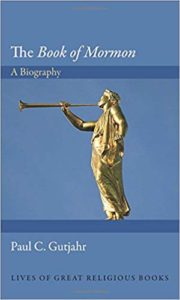David Harris has been reading and reviewing Mormon literature (along with a lot of other books, including many on Middle Eastern societies) on Goodreads for the last several years. I have enjoyed his reviews, and he gave me permission to repost them here. Among the authors’ whose books David reviewed are Samuel W. Taylor, Lowell L. Bennion, Levi S. Peterson, Linda Sillitoe, John Bennion, Brady Udall, Douglas Thayer (2), David Ebershoff, Jonathan Langford, Todd Robert Petersen, Jack Harrell, George B. Handley, Steven L. Peck (4), Andrew Hunt, Ryan McIlvian, Craig Harline, Mette Ivie Harrison (3), David G. Pace, and Steve Young.
David grew up in a large Mormon family in Provo, Utah. An avid reader of both fiction and nonfiction, he is currently working on his own novel, Book of Mormon Stories. His great-great-grandfather, Martin Henderson Harris, founded the city of Harrisville, Utah near Ogden in the 1850s, and his great-grandfather, Nathan Harris, was both a territorial judge and a member of the territorial legislature when Utah became a state.
 Samuel W. Taylor. Heaven Knows Why! A. A. Wyn, 1948. 4 stars.
Samuel W. Taylor. Heaven Knows Why! A. A. Wyn, 1948. 4 stars.
This is a lighthearted romantic adventure set in Mormon country. First published in 1948 by a grandson of Mormon prophet John Taylor, the book is a quick read, and the author isn’t afraid to spice his story up with such controversial elements as embezzlers, idlers and apostates along with misadventures relating to the improper consumption of coffee and alcohol.
I enjoy the more contemporary Mormon fiction of such authors as Levi Peterson and Doug Thayer, and I recently discovered Jack Harrell short stories and David Pace’s new novel Dream House on Golan Drive.
Heaven Knows Why was entertaining but also interesting as a window into an earlier period of Mormon writing.
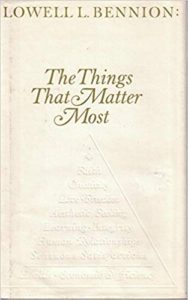 Lowell L. Bennion. The Things that Matter Most. Deseret Book, 1978. 4 stars.
Lowell L. Bennion. The Things that Matter Most. Deseret Book, 1978. 4 stars.
This is a short book which can be read in one or two sittings. The content seems pretty self evident to me as I imagine it would to most people in their middle or later years, but the prose has a pleasing balance and rhythm to it which makes it an enjoyable read. I would describe it as a combination of the wisdom of scripture and more secular knowledge about the good life as described by Aristotle in ancient Greece among others with a smattering of Bennion’s own life experiences added for good measure.
I wish more people, including many of our political and religious leaders, could more thoroughly internalize these principles because I believe the country and the world would become a much better place as a result. I find it particularly disconcerting that so many US politicians wear their religion on their sleeve yet have so little concept of the responsibilities that go along with the religious rights they are always publicly clamoring for. But this book offers its readers some peace in the midst of all the chaos that surrounds our troubled country as we anticipate the era of Donald Trump.
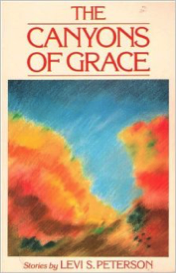 Levi S. Peterson. Canyons of Grace: Stories. University of Illinois Press, 1982. 5 stars.
Levi S. Peterson. Canyons of Grace: Stories. University of Illinois Press, 1982. 5 stars.
This is a very successful work of literature in my view, and I particularly value the way these stories illuminate various aspects of the Mormon culture I grew up in and am still heavily involved with. The sheer variety of characters and situations from story to story is astounding, and the author’s ability to describe Western American landscapes in poetic yet realistic detail is striking to me yet again in re-visiting these stories a couple of decades after having originally read them.
For me, the quality of Levi Peterson’s fiction rises far above that of any other fiction written in the context of Mormon culture which I’ve encountered. I believe there are a couple of reasons for this:
First, Peterson has a familiarity with Western landscapes and an ability to describe them in detailed yet readable prose which rivals that of any other prose or any poetry I have ever come across. And this ability extends to the human beings who populate his stories, as well. Their motivations and the way they speak to each other comes across as authentic if not always pretty. And the situations they find themselves in, though often bizarre or at least out of the ordinary, strike me as completely plausible.
Second, stories with an agenda almost always lack authenticity. This isn’t true by definition, and I’m sure it’s possible for a story written to promote a specific point of view to reflect reality in genuine ways. But, in my experience, it generally doesn’t.
Many stories that come out of Mormon culture are intended to build faith and encourage church activity. There’s nothing wrong with that, but it is important to recognize that a faith promoting agenda is still an agenda. When the author’s goal is to build faith, certain paths in a potential storyline are blocked by necessity. That constrains the author’s imagination, which tends to limit what becomes possible. And that, in turn, lessens the potential impact of a story on a reader’s imagination.
I have some advice for those who might forego reading this author’s work out of a fear that they might become “infected” by what they view as heretical ideas in these stories:
Don’t feel like you have to buy into the world view of the protagonist in a specific story. Just read each story as if you were listening to a friend tell you about a personal experience. Withhold any judgment until you’ve taken it all in and had an opportunity to evaluate it. Finally, don‘t judge the writing by the beliefs or actions of the protagonist. Accept that the author is just the messenger. He’s not trying to convince you to embrace the actions or philosophy of the protagonist. He’s just showing you what’s there. What you make of it is up to you.
Finally, don’t miss Peterson’s best short story ever. It’s called “The Gift”, and it’s about an American missionary serving in the Belgian city of Liège. It can be found in the book Greening Wheat, which is a collection of short stories from various authors in the Mormon tradition. Like Canyons of Grace, it’s out of print now, but there are used copies floating around out there.
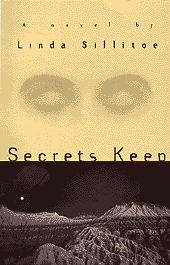 Linda Sillitoe. Secrets Keep. Signature, 1995. 5 stars.
Linda Sillitoe. Secrets Keep. Signature, 1995. 5 stars.
I picked up this book along with a poetry book by the same author at the sales tables at Sunstone 2018. I’ve read lots of Mormon / Utah fiction, and I have to say that this book is unique in that it’s a detective novel with an emphasis on magical realism and indigenous medicine.
Each chapter is written from the perspective of one of the characters in the novel, namely Caitlin and her siblings along with three or four other ancillary characters. Sillitoe did not invent this technique, but it works well in this novel.
Marly, one of Caitlin’s sisters, is perhaps my favorite character in the book. A bit of a free spirit, she lives alone in an apartment in downtown Salt Lake City and walks or rides buses to her job at the public library and elsewhere around town. She dresses in an eccentric manner, tying her long hair back in a haphazard manner, and she plays the organ in her local ward or congregation. Like her sister Caitlin, she has a special ability to see things most people can’t see, and she routinely sends anonymous notes to her bishop advising him on who in the ward is in special need of his attention.
There are a couple of major plot points in the book which are never resolved to my satisfaction, particularly one involving Roger, Caitlin’s brother. But Sillitoe has created here a realistic extended Utah family with believable family dynamics revolving mostly around their relationship to their native Mormonism. I highly recommend the book to those interested in a realistic portrayal of life in a contemporary Mormon family.
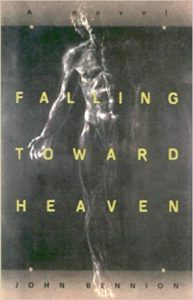 John Bennion. Falling Toward Heaven. Signature, 2000. 5 stars.
John Bennion. Falling Toward Heaven. Signature, 2000. 5 stars.
I enjoyed this Mormon-themed novel. It’s about faith and the compromises religious people must strike with loved ones who don’t share their beliefs. Its strong points are the three-dimensional characters which inhabit the plot and Bennion’s ability to create strong dialog.
My favorite character was Howard’s mother, Emily, who is introduced to the reader early on in the novel through a letter she has written to her missionary son. In it, she confesses to him that she has been blessing women in the ward who have come to her with health problems or other stresses in their lives. She has been doing this by means of her husband’s priesthood, which worries her. However, without exception, she informs her son, all have been healed. So how can this be wrong? she asks him.
I also enjoyed the varied venues in which the plot took place, these being Houston; a rural Utah farm; Salt Lake City; and Anchorage, Alaska.
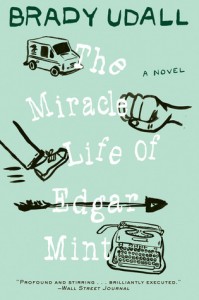 Brady Udall. The Miracle Life of Edgar Mint. Vintage, 2001. 3 stars.
Brady Udall. The Miracle Life of Edgar Mint. Vintage, 2001. 3 stars.
I enjoyed this book, but I think I probably enjoyed Brady’s more recent novel, The Lonely Polygamist, more. The weird (and kind of fun) discovery I made while reading this book was that I had actually read it before. I don’t remember when or where, but it must have been shortly after the book came out in 2002. This discovery came to me gradually as certain plot elements started to seem familiar. That made it almost like remembering a long forgotten but real event from my own life, which is a fun thing to have happen.
My only real disappointment about the book was that it didn’t contain more positive references to elements of Native American culture.
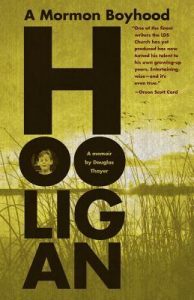 Douglas Thayer. Hooligan: A Mormon Boyhood. Zarahemla, 2007. 5 stars.
Douglas Thayer. Hooligan: A Mormon Boyhood. Zarahemla, 2007. 5 stars.
This is an enjoyable book for anyone who grew up in Utah during the 1930s. My parents, who are from Ogden and Logan, both found much that was familiar to them in the book, including memories of jumping up into the ice man’s wagon for ice chips on hot summer days.
I grew up in Provo in the 1970s right at the tail end of the era Thayer covers in this book, and I remember the downtown movie theaters, early morning paper routes, and hiking and camping out up Rock Canyon with our pellet guns and .22s. Things changed a lot in the 1980s when the effects of the University Mall on downtown Provo became more evident and again in the 1990s with the advent of the internet.
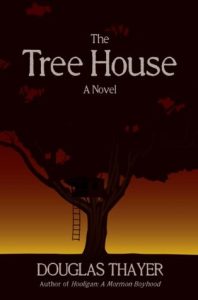 Douglas Thayer. The Tree House. Zarahemla, 2008. 4 stars.
Douglas Thayer. The Tree House. Zarahemla, 2008. 4 stars.
This novel can be considered a sequel to Thayer’s memoir of growing up in Provo, Hooligan. It’s not quite as readable as Hooligan in my opinion, although it’s every bit as interesting if you’re willing to give it a chance, and it tells a story about a specific time and place which you would have difficulty finding anywhere else. Which is why I decided to give it 4 stars rather than the 3 I had originally planned on giving it.
I found the chapters on serving as a missionary in Germany right after World War II very interesting. I was a missionary in Germany in the early 1980s just 35 years after World War II, but Germany had long since re-built, and we always felt reluctant to bring up the war with the people we met, although the subject did arise on occasion. It was only years later that I realized how recent that war still was then, and I regret that I didn’t take more time to learn about it from the people I met in Germany at that time.
The section on the Korean conflict was particularly well written, and Thayer managed to capture both the horrific ugliness of war along with the mundane hours and days of wasted time and resources.
Some questions I have which I wish I could ask the author, who passed away just last week:
Why did he choose to have the main character be named Harris Thatcher? The ‘Thatcher’ part seems easy. It’s probably just a modified form of ‘Thayer’. But ‘Harris’ as a first name struck me as odd. That’s my surname, but I’ve never in my life come across anyone with the given name Harris. And, if I had, I expect they would have gone by ‘Harry’. I remember that a few people in school called me Harry back in the day, and at least one former missionary companion still does. But ‘Harris’ as a given name seems like an odd choice if your goal is realism, which I’d have to see this story’s author’s goal must have been.
Throughout the book, Thayer returns to the subject of the treehouse, but it seemed to me that it could have been used even more as a unifying symbol to bring all parts of the story together than it was. I understand how Harris could have lost interest in the treehouse once he started to experience grown up life, but I wonder why he would never have climbed up into the tree house ever again after his 16th birthday. Perhaps the trauma of his father’s death makes this realistic, but wouldn’t sheer nostalgia have driven him up there at least once upon his return from his mission or from basic training or from war? I would think so.
I also felt like Harris’s reaction to being at war was not described in as much detail as it could have been. I don’t know how to explain myself as well as I perhaps could, but I just felt like the trauma it would have taken to bring him as low as he got was not spelled out as clearly as I felt it should be.
I also thought it was odd that his only two siblings were brothers almost ten years younger than him. Perhaps this is based on the author’s own situation. But it seems like the addition of a sister or two or less of a gap in the ages of himself and his siblings could have added to the human element.
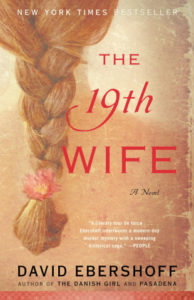 David Ebershoff. The 19th Wife. Random House, 2008. 3 stars.
David Ebershoff. The 19th Wife. Random House, 2008. 3 stars.
This was an enjoyable read aside from a disturbing story accusing Brigham Young of ruining a man financially in order to pressure his sister into marrying him. I’m not sure that actually ever happened (probably not), but then Brigham Young clearly has a lot to answer for already. (I say this despite the fact that he was also a great leader who accomplished much for the Church.)
The fun part of the story is how the two main stories, one from the 19th century and one from today, come together at the end.
In any case, please read the author’s notes at the end of the book explaining his sources and what is fictional and what is not.
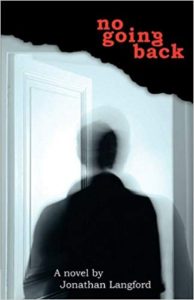 Jonathan Langford. No Going Back. Zarahemla, 2009. 4 stars.
Jonathan Langford. No Going Back. Zarahemla, 2009. 4 stars.
This is one of 15 or 20 books I picked up from the sales tables at Benchmark Books at the Sunstone symposium a couple of weeks ago (July 2018).
I’ve been interested in Mormon fiction for a long time. This novel is a bit unusual compared to many of the others I have read over the years in that it reads like a young adult novel. Ordinarily, I wouldn’t be that interested in a book like that, but I enjoyed the authentic feel the book had in describing a Mormon ward outside of Utah.
Plus the book addresses a very important issue, namely what options LGBT people have for dealing with a religion which tells them that the feelings they have are wrong and that they should be denied or, as they put it, “not acted on”. I think the book asks a lot of useful questions even if it is a little bit too biased on the church side.
I recommend this book for young adult readers and those adults who deal with young adults on a regular basis, particularly if they are Mormon. But my guess is that there are probably better books out there.
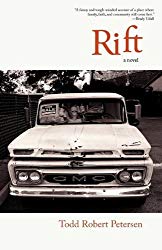 Todd Robert Petersen. Rift. Zarahemla, 2009. 5 stars.
Todd Robert Petersen. Rift. Zarahemla, 2009. 5 stars.
There is lots of Mormon fiction out there, and a great deal of it is fairly mediocre. But there are also some very talented authors in this genre, and it is worth seeking them out.
I found a copy of this book on the sales table at the Benchmark Books exhibit at Sunstone in July of 2018. I’m really glad I picked it up. Petersen’s writing style is very descriptive, and I enjoyed the picture he paints here of small-town Sanpete County, Utah and of the landscapes surrounding it. The novel is also peopled with lots of great rural-Utah characters, both Mormon and non-Mormon. These things reminded me of Levi Peterson and, indeed, I would put this Petersen right up there with that Peterson in terms of the quality of his prose and of the story he tells here.
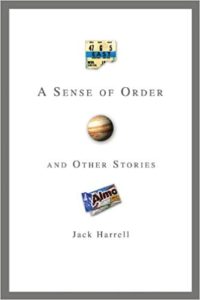 Jack Harell. A Sense of Order. Signature, 2010. 5 stars.
Jack Harell. A Sense of Order. Signature, 2010. 5 stars.
I’m a big fan of the fiction of Levi Peterson and Douglas Thayer which is informed by the American West, Utah and Mormonism. I can now add Jack Harrell, a professor of literature at BYU-Idaho in Rexburg, to my list of favorites. The short stories in this book introduced me to a wide variety of characters and made me genuinely interested in their lives. I highly recommend this short story collection. Now that I have finished it, I intend to read Harrell’s award-winning novel, Vernal Promises, which came out in 2003.
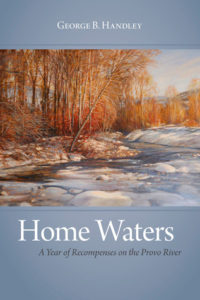 George B. Handley. Home Waters: A Year of Recompenses on the Provo River. University of Utah Press, 2010. 3 stars.
George B. Handley. Home Waters: A Year of Recompenses on the Provo River. University of Utah Press, 2010. 3 stars.
I read this book at the same time I was reading Notes on a River, a sort of history and travelogue of the Colorado River. I expected the river to be the main focus of this book as it was with NoaR, but the river was only part of the story. Which is fine, it just wasn’t what I was expecting.
Handley is a Mormon, and this book follows in the tradition of Eugene England and others who write personal essays relating to their faith and other meaningful elements of their lives. On this first reading, I skipped over the parts that didn’t directly relate to the river. But I will probably come back to the book at some point in the future because, now that I know how the book is structured, I think I will probably enjoy it more than next time around.
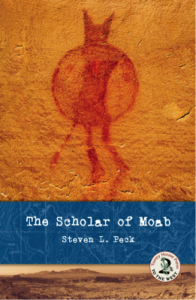 Steven L. Peck. The Scholar of Moab. Torrey House, 2011. 4 stars.
Steven L. Peck. The Scholar of Moab. Torrey House, 2011. 4 stars.
This book deserves lots of points for creativity and sheer inventiveness. Mormon fiction has rarely seen such an abundance of colorful and eccentric characters, the least interesting of which are the protagonist, Hyrum Thayne, and his acolytes from the church community of Moab.
Scattered here and there throughout the book are passages filled with philosophy and ruminations on the red-rock landscape surrounding Moab that make for enjoyable reading. These passages make me interested in reading more of this author’s fiction and a couple of his works on theology of which I am aware.
While reading this book, I couldn’t help but draw parallels to A Confederacy of Dunces. This book would seem in many ways to be a rural Mormon retelling of that story. I loved that book, but it seems to me that it’s a little too easy to invent humor based on poorly educated and superstitious personalities. And, after a while, that gets a bit tedious.
I found the Babcock twins/triplets and poetess Dora Daphne Tanner much more interesting than I did Hyrum, and I probably would have preferred to have the focus be more on them than on him. Still, there are aspects of his relationship to those characters which continue to interest me and which I will continue to ruminate on. I plan to look through some of the other reviews of this book on Goodreads to see if anyone else has insights which will better inform my understanding of their role in the story.
I recommend the book to those who are looking for more from Mormon fiction than what’s currently out there. And I would add that you don’t have to be a Mormon to enjoy it. If you’re interested in experiencing the flavor of Southern Utah, you’ll get that here. And you may want to mix it with a healthy dose of Levi Peterson’s short stories, as well, to get a clearer picture of what life is like in the small towns south of the Wasatch Front.
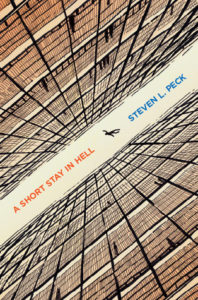 Steven L. Peck. A Short Stay in Hell. Strange Violins, 2012. 5 stars.
Steven L. Peck. A Short Stay in Hell. Strange Violins, 2012. 5 stars.
This story is just 100 pages long and can be read in one sitting. It’s an interesting addition to Peck’s other literary endeavors, ie. short stories (Wandering Realities) and a novel (The Scholar of Moab) as well as books on science and Mormon theology.
I’m impressed at the variety of Peck’s writing and the amount of his output. And I’m happy to know that there is still serious work going on in Mormon letters.
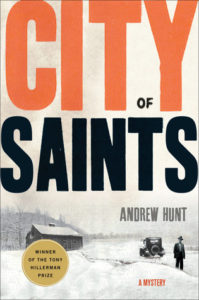 Andrew Hunt. City of Saints. Minotaur Books, 2012. 5 stars.
Andrew Hunt. City of Saints. Minotaur Books, 2012. 5 stars.
An interesting look at 1930s Salt Lake City through the eyes of a police detective investigating a murder. This is the first of two books featuring Art Oveson, a Latter Day Saint law enforcement officer of the early 1930s. I think the author gets minor details here and there wrong but, for the most part, it’s a colorful and entertaining read.
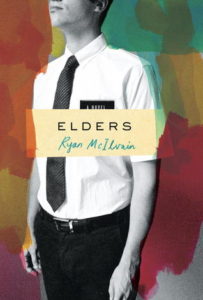 Ryan McIlvain. Elders. Hogarth, 2013. 2 stars.
Ryan McIlvain. Elders. Hogarth, 2013. 2 stars.
This book is very well written, and I enjoyed reading it. Plus, if you’ve done an LDS mission, it’s always interesting to hear about someone else’s mission experience. (Presumably, the author went on a mission to Brazil and brought a lot of his own experiences into the story.) I thought the characters were interesting, as well.
If there’s anything I disliked about the book, it’s just that it was way too dark and left no possibility of any sort of positive outcome at the end. In that way, it sort of reminded me of Richard Dutcher’s autobiographical (I think) film Falling. I do understand that both are allegorical tales about leaving the LDS church. But I don’t believe that everyone who leaves the Church falls into an abyss of complete and utter hopelessness. If they do, they’d probably have been better off staying.
Anyway, I did like the book enough to read it to the end, and I have to admit I’m curious what happens to the main character after he gets back home to Boston.
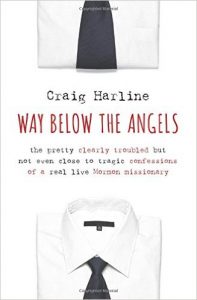 Craig Harline. Way Below the Angels: The Pretty Clearly Troubled But Not Even Close to Tragic Confessions of a Real Live Mormon Missionary. Atheneum, 2014. 3 stars.
Craig Harline. Way Below the Angels: The Pretty Clearly Troubled But Not Even Close to Tragic Confessions of a Real Live Mormon Missionary. Atheneum, 2014. 3 stars.
I appreciate this author’s efforts to avoid the temptation to treat the experience of a mission euphemistically. It’s understandable that people in the business of preaching for the purpose of gathering converts would want to cast that work in as positive a light as possible. But Mr. Harline sees honesty and objective truth as a higher good, and that makes for a very useful contribution.
I was a bit put off by the author’s writing style at first. I don’t really go in for clever turns of phrase and silly acronyms like VOM for vintage old man or POL for precious old ladies. Also, the never ending repetition of the phrase “local businessmen” to refer to missionaries got old really fast. Yes, it’s odd that teenagers called to preach the gospel are required to dress up in suits and ties to present themselves to the world. And, yes, it’s kind of jarring when you encounter Wall Street-styled executives on the street for the first time and are tempted to think they are Mormon missionaries. But that phrase got old really fast.
Another thing that put me off was the author’s emphasis on the desire to be a leader, ie. aspiring to the position of district leader, zone leader or the even loftier position of assistant to the president. But I liked that he evolved away from that crass way of thinking as he progressed through his mission. And, again, I appreciated the honesty in his portrayal of his thought processes at various points in his mission.
The last few chapters of the book are the most satisfying. Harline finally comes to terms with the fact that he will not only not reach his goal of 84 baptisms but may not end up making even one real convert before he finishes his mission and goes home. His perspective about what he is doing in Belgium begins to change. He talks about “going native” and actually admits that, in many real ways, the people of Belgium ultimately influenced his intellectual development much more than he did theirs. He befriends pastors and priests and talks of the inspirational meetings he attends in Catholic and Protestant churches. He makes lifelong friends during these latter months of his mission as he learns to value the art of conversation for its own sake and the give and take of true friendships. And many of these friendships extend for years beyond his return from the mission.
For an alternate view of missionary life in Belgium in the mid- to late 20th century, I highly recommend Levi Peterson’s short story “The Gift”, which can be found in the short-story collection Greening Wheat. (That book is long out of print but can still be found in used editions.) The story is a mix of faith, ecumenical explorations, illicit love and interdenominational tolerance, and I believe it represents the pinnacle of Mormon literature… So far.
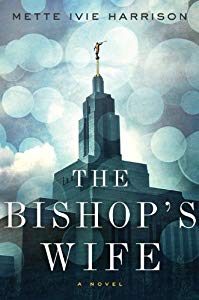 Mette Ivie Harrison. The Bishop’s Wife. Soho, 2014. 3 stars.
Mette Ivie Harrison. The Bishop’s Wife. Soho, 2014. 3 stars.
I was hoping this would make a good Mother’s Day gift for my mother next month. However, after reading it myself, I’ve decided I wouldn’t feel comfortable giving it to her because the worldview portrayed in it is just too bleak for pleasure reading.
That said, I did enjoy this detailed portrayal of a Mormon family and ward. I grew up in a Mormon family in Provo and I’m now living in Salt Lake City, and it is fun to see how various authors portray the culture I know so well. I identify with the Levi Peterson school of Mormon writing, but I believe Harrison does a good job explaining culture-specific phenomena without letting it get in the way of telling the story. Her prose has an easy conversational style which I like. And I like that she’s not afraid to broach sensitive topics relating to religion which other Mormon authors often shy away from.
One last thought which seems relevant to this novel: In recent decades, we’ve become more and more aware of inherently sexist vocabulary and grammar in our language. For the most part, such biases undermine women or gays or, really, anyone who isn’t a heterosexual male. I support efforts to re-think our language if it can help to alleviate this problem. However, I can think of at least one word pair which would seem to disadvantage males, and that is ‘misogynist’ versus ‘misanthropist’. The former describes an anti-woman bias or behavior whereas the latter has a more generic meaning which applies to human beings across the board. Obviously, no one deliberately set up the language to work this way. However, it seems to me it does make it easier to obscure anti-male behaviors and biases in this age of hyper-awareness surrounding discrimination.
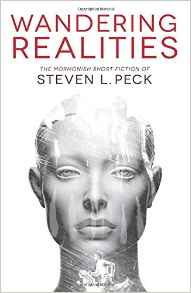 Steven L. Peck. Wandering Realities: Mormonish Short Fiction. Zarahemla, 2015. 5 stars.
Steven L. Peck. Wandering Realities: Mormonish Short Fiction. Zarahemla, 2015. 5 stars.
The short stories in this book are divided into two sections, one labeled ‘Other Worlds’ and the other ‘This World’. As these section headers suggest, many of the stories contain science fiction elements. All of the stories reflect or refer to Mormon culture in some way. Some of them poke fun at LDS Church policies such as the prohibition on popular music and on specific musical instruments in sacrament meeting or the pioneer reenactments that the youth organizations sometimes engage in.
Reading these stories reminded me of the exhilaration I felt as a kid when I first encountered science fiction authors like Ray Bradbury and Isaac Asimov. There’s a lot of freshness in the quirky ideas presented and explored in the stories. A couple of the stories are a little over the top in the scenarios they present, but that’s to be expected in an experimental collection like this, and their inclusion only adds to the value of the collection as a whole in my opinion.
One of the most inventive of these short stories is entitled “A Strange Report From The Church Archives.” It explores the mess that we can make of our own lives and, indeed, of the whole world when we are granted the ability to have our wishes fulfilled. The story is cleverly constructed, and I highly recommend it.
Other highlights include “Avek Who Is Distributed“, “Best Pinewood Derby Ever” and “The Problem”, a serious exploration of overwhelming lust and how it is dealt with in a religious context.
While many of the stories contain an element of humor, some are more serious in nature. At least one addresses the very real moral quandary of how some successful Mormons make their livings and the soul-deadening impact this often has on a person who makes that choice. Another tackles the tricky issue of a suicide pact between elderly friends who fear the debilitating effects of dementia.
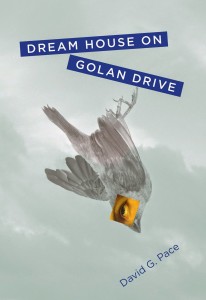 David G. Pace. Dream House on Golan Drive. Signature, 2015. 5 stars.
David G. Pace. Dream House on Golan Drive. Signature, 2015. 5 stars.
I knew the author of this novel briefly in junior high school in Provo before we went our separate ways to different Provo high schools and on to different lives. I enjoyed reading it for a variety of reasons.
First, having grown up in Provo myself at the same time as Pace, it was fun to compare his description of those days with my own memories of that time. Many things about the town and the local culture were familiar, but some were not. For example, we never had a ‘postum table’ at our house. We simply called it by the worldly term, ‘coffee table’. Although we certainly did avoid coffee and alcohol and even caffeinated cola drinks, none of which you would ever find in our house aside from an old bottle of cooking sherry with a faded label which virtually never got used and was eventually thrown away.
Like Pace, I also attended BYU, and I particularly enjoyed the scenes and dialog which take place with the professor Pace identifies as Roland. They recalled fond memories of thoughtful discussions with both students and professors at that time. Some very interesting ideas arose out of that unique academic environment. Many of these seem crazy to me now, but I still find my world view to be in alignment with some of this thinking.
I’m also very interested in Mormon fiction and have long been a fan of such authors as Doug Thayer and Levi Peterson. I enjoyed the novel Earthkeepers by Marilyn Brown, also set in Provo, and, recently, I discovered the short stories of Jack Harrell. I’m always happy to discover new authors who address Mormon themes in their work.
One of several fun ingredients in the novel was the appearance of Zed, one of the three Nephites who, like John the Beloved, are fated to wander the earth until Jesus Christ’s second coming. Riley, the main character, is one of his charges, and he discusses Riley’s adventures with his immortal buddy, the Wandering Jew, as he watches over him and attempts to subtly steer him right.
Finally, I’m a big fan of Western landscapes, and I enjoyed the descriptions of the Wasatch Mountains and other roadside scenery in the three road trips that happen during the course of the novel.
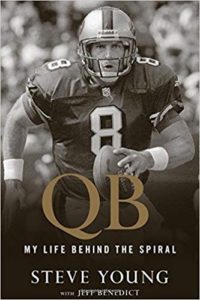 Steve Young. QB: My Life Behind the Spiral. Houghton Mifflin, 2016. 3 stars.
Steve Young. QB: My Life Behind the Spiral. Houghton Mifflin, 2016. 3 stars.
I’m not much of a competitive sports fan, but I admire Young for his courageous stance on accepting and celebrating LGBT youth. I enjoyed reading various chapters in this book, but I mostly skipped the football parts. Having been raised in the Mormon church myself, it was interesting to compare notes with his upbringing in the same faith. I also enjoyed reading about how he met his wife and about where his life has led him since he retired from the NFL.
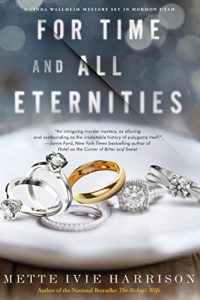 Mette Ivie Harrison. For Time and All Eternities. Soho, 2016. 2 stars.
Mette Ivie Harrison. For Time and All Eternities. Soho, 2016. 2 stars.
I think it’s good to fight for things you believe in and to work to change things that are wrong. And I agree with this author that polygamy as practiced by certain authoritarian groups and anti-gay discrimination wherever it crops up are both valid targets for criticism. However, literature written in the service of a cause often falls flat when it becomes so consumed with making its case in support of its cause that it fails to tell a good story.
So many of the details of this story seem contrived. Here are just three examples of many:
1- Naomi knows her half sister is being abused, but she doesn’t know who’s behind it. Turns out it’s the girl’s own mother, yet no one ever saw it until she slapped her in public. 2- Linda Wallheim feels compelled to stick her nose in everyone’s business on the compound, yet no one complains. 3- Linda and her son, Kenneth, casually go along with a polygamous wife’s plan to cover up the murder of her husband and are not charged with a crime.
I think this author has narrative skill and lots of promise as an author. I’m confident she can do much better than she’s done here.
 Mette Ivie Harrison. The Book of Laman. BCC Press, 2017. 3 stars.
Mette Ivie Harrison. The Book of Laman. BCC Press, 2017. 3 stars.
I was looking forward to this re-telling of the first part of the Book of Mormon story from the perspective of the black sheep of the family because I’ve found that alternate re-tellings of a long familiar story can often be very illuminating.
The story held my interest, making me want to read all the way to the end. I think it works reasonably successfully as a re-telling of the story from the viewpoint of a different character, but I found many aspects of it to be unsatisfying.
I think Harrison’s main objective in writing the book was to flesh out Laman’s character and to explore ways in which he might be similar to many of us. The book succeeds to some degree on this count, and I enjoyed reading Laman’s introspective internal dialogues / soliloquies.
One thing that surprised me was the great liberties the author took with certain aspects of the story, among them her portrayal of a Lehi as a drunk and a scoundrel earlier in his life. I certainly wouldn’t say I was offended by this. It’s just that it seemed unnecessary to invent this detail, which is completely out of character with the character of Lehi I know from the text.
As for Nephi, maybe there really aren’t any redeeming traits which can be illuminated in his character. Certainly, Harrison found none.
I was also a bit put off by much of the dialogue. A lot of it seemed overly earnest to me, and I felt that injecting a bit of humor into the story could have helped a lot.
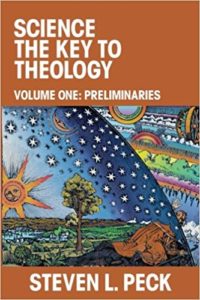 Steven L. Peck. Science: The Key to Theology. BCC Press, 2017. 4 stars.
Steven L. Peck. Science: The Key to Theology. BCC Press, 2017. 4 stars.
I really like the format of this book. After every two chapters, there is a short interlude in the form of a poem or story or short essay. This helps to break up the material in the book in a systematic way.
That said, I really struggle with the language of philosophy, which includes terminology necessary for understanding theology. Consequently, I think tackling this book requires more bandwidth than I currently have, so I have only leafed through the book for the time being and plan to return to it for a more serious reading sometime in the future.
I’ve struggled similarly with Blake Ostler’s book on Mormon theology entitled Exploring Mormon Thought and other readings in theology I have encountered in recent years.
It has occurred to me that earlier works on the subject might be less wrapped up in the complex language of philosophy, and I recently purchased a copy of Sterling M. McMurrin’s The Theological Foundations of the Mormon Religion which I hope to get to soon.
History books
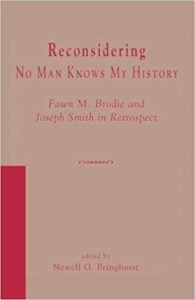 Newell Bringhurst. Reconsidering No Man Knows My History. Utah State University Press, 1996. 4 stars.
Newell Bringhurst. Reconsidering No Man Knows My History. Utah State University Press, 1996. 4 stars.
This book is a series of articles about the original biography. I didn’t read them all, and probably only a specialist in history or biography would really want to do that. I did read two of the articles and skimmed a third.
The most interesting and most accessible article, I think, is the first, which is entitled “A Biography of the Biography: The Research and Writing of No Man Knows My History“. Having just read Bringhurst’s biography of Brodie, a lot of this was redundant information for me. But I would recommend it in lieu of the full FMB biography for those who are more interested in her Joseph Smith book specifically.
Lavina Fielding Anderson’s article on literary style, the fifth article in the book, was an interesting look at Brodie’s writing style with lots of excerpts which give you a flavor for the prose of the original biography. Which might be useful to someone thinking about whether or not to read the biography. I found it interesting, but I have to confess I did skim through a lot of it.
Todd Compton’s article on Brodie’s treatment of polygamy in the biography contains interesting information about what Brodie got right and what she got wrong, pointing out that the Church’s decision to withhold access to some early church records deemed too sensitive for public consumption backfired on them in Brodie’s case in a sense in that it caused her to come down harder on Smith in a couple of minor cases than she otherwise might have.
All in all, though, if you’re not a historian and are more interested in biography for its own sake without feeling like you need to revisit the details of how sources were utilized in its creation, then I’d recommend skipping this and moving straight to No Man Knows My History itself or another good biography such as Bringhurst’s biography of Brodie or perhaps Newell and Avery’s Mormon Enigma: Emma Hale Smith. Boyd Peterson’s Nibley biography is a great read, as well, as is the David O McKay bio by Greg Prince
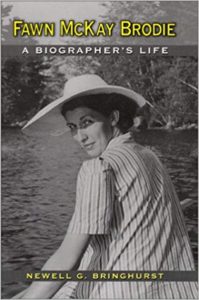 Newell Bringhurst. Fawn McKay Brodie: A Biographer’s Life. University of Oklahoma Press, 1999. 4 stars.
Newell Bringhurst. Fawn McKay Brodie: A Biographer’s Life. University of Oklahoma Press, 1999. 4 stars.
I picked up this book because I was curious about the details behind Brodie’s excommunication from the Mormon church shortly after her biography of Joseph Smith was published in the mid-40s. The book engaged me from start to finish. And, yes, it answered the questions I had had about her excommunication.
I was impressed with the level of detail Bringhurst brought to every period of Brodie’s life in these pages, and I appreciated the differing perspective about life in the McKay clan after having recently read and enjoyed David O. McKay and the Rise of Modern Mormonism.
Like any good biography, this book reads like a novel. It’s straightforward and easy to follow, yet all the footnotes are there for anyone who wants to delve deeper into the sources and/or background of specific points. I have yet to read a Brodie-penned biography, but I am very curious to do so now if only to compare her style to that of her biographer.
The author clearly admires Brodie, yet I felt that the book was neutral in tone and not overly indulgent of Fawn and Bernard. It included interesting information about their marriage, their family life, their children and also of the interesting time in which they were active and of the many prominent characters they interacted with in the various places they called home over their many decades together. Henry Kissinger was just one of these.
One final thought: The book raised some interesting questions in my mind about the notion of biography in general. For example, would Brodie’s life have been any less interesting if she hadn’t penned the five biographies she is famous for? Probably not, I think. Which leads me to believe that a great many other less accomplished people would probably be equally interesting subjects for biographies of their own if we only had the same sort of access to their inner lives and thinking that we do to typical subjects of traditional biographies through their letters and other writings and through interviews of those who knew them well.
I discovered this book after having read a “biography” of the Quran. Both books are written on a similar model, that of tracking the influence of a specific book across history and noting how the book changes influential people across the ages and also how the attention those same people give the book changes perceptions of the book and its role in various cultures through time.
The Quran: a Biography, by Bruce Lawrence, is part of a series called Books That Shook the World which is being published by the Atlantic Monthly. This book, on the other hand, is a part of Princeton University’s Lives of Great Religious Books series. But I understand that Bruce Lawrence will be adding a title about the Quran to this series, as well. It will be interesting to see how it differs from his Books That Shook the World volume. (I can’t imagine how that book could be improved upon, but I’m open to the idea.)
This book (The Book of Mormon: A Biography) is well written, but it suffers upon comparison with the Qur’an biography. But that’s probably because there’s just not enough history behind the Book of Mormon yet after a mere 180 or so years with which to fill such a volume.
That said, it’s unfortunate that the author failed to devote more space to Grant Hardy, author of Understanding the Book of Mormon, in his survey. Hardy has brought a very interesting psychological component to the three major authors/editors of the Book of Mormon (Nephi, Mormon and Moroni) by conducting a thorough literary analysis of the text from their various perspectives. He only gets a short paragraph of mention here.
The chapters on illustration and stage and screen were interesting, including the section on the Book of Mormon musical that’s popular at the moment.
Overall, this book presented information about the Book of Mormon in a way different from how it usually gets presented, and that makes it worth a read. I hope the author will expand the section on literary criticism of the book in future editions, especially Grant Hardy’s work.
Featured Photo by Jamie Taylor

